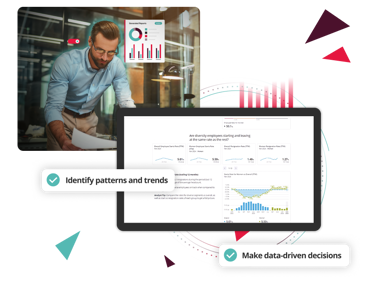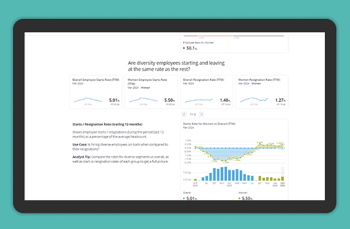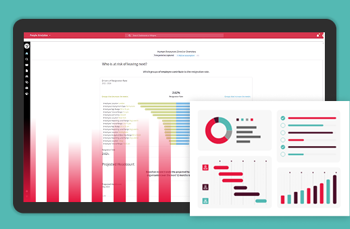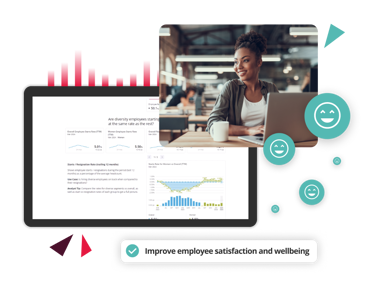What is people analytics? A definitive guide for SMBs
As businesses continue to introduce data-driven practices into their HR operations, people analytics has become increasingly valuable overall business success. The importance of people analytics lies in its ability to transform workforce data into actionable insights, helping businesses to make informed decisions that support both employee wellbeing and organisational goals. But what is people analytics, and how can it help you to improve HR strategies and employee performance?

In this guide, we’ll explore the benefits of people analytics, highlight top trends, and outline the steps your business needs to take to start leveraging this practice effectively. We’ll also what are the people analytics insights that reveal employee motivations and assess how effectively organisational processes meet workforce needs...
What are people analytics and why do they matter?
People analytics is the practice of collecting and interpreting employee data, such as engagement, turnover and productivity, to make data-driven decisions that benefit both the company and its employees. It provides insights into how your workforce operates, enabling organisation to optimise HR and business outcomes by putting targeted strategies in place.
At its core, these analytics help businesses to identify patterns and trends within their workforce. For example, what are the common traits of high-performing employees, and what factors contribute to employee turnover? By answering these questions, businesses can tailor their HR policies to enhance performance and employee satisfaction.

The importance of people analytics
People data isn’t just about numbers; it’s about understanding the people behind the data. This practice helps businesses to learn more about their workforce, what motivates them, and how effectively organisational processes are able to meet their needs.
By embracing this data, businesses can:
- Identify patterns in employee behaviour that may affect productivity
- Address issues related to staff turnover and employee satisfaction
- Ensure that HR strategies align with business goalsTrack the impact of HR initiatives to improve
- decision-makingSpot potential HR challenges before they become major issues

Benefits of people analytics
The benefits of people analytics are substantial, especially for SMBs looking to enhance their HR practices and create a more impactful workforce. Here’s a look at how this can transform your organisation:
1. Optimises HR strategies
HR trends highlight the growing reliance on analytics in shaping future HR strategies. People analytics allows SMBs to use data to shape HR strategies that better align with their overall business goals. This data-driven approach leads to more effective decision making and ensures that your efforts are targeted and efficient.
By analysing employee performance, satisfaction levels and engagement metrics, businesses can implement HR strategies tailored to their specific goals. For instance, data can reveal which training programs yield the best results, allowing you to allocate resources effectively. This ensures that both business needs and employee goals are met.
2. Improves productivity
By analysing data on employee behaviour and performance, SMBs can identify opportunities to improve productivity. Whether it’s optimising workflows or addressing issues that impact employee performance, one of the benefits of people analytics is its ability to help businesses make improvements based on real data.
By identifying bottlenecks and inefficiencies within your teams, this data allows you to streamline processes and ensure that all employees can work productively. Data on employee performance can highlight underachievers and those who may need additional support or training, enabling you to plug skills gaps and help employees to meet their full potential.
3. Supports employee retention
Understanding your employees’ needs is essential to boost staff retention. For businesses looking to minimise turnover rates, the importance of people analytics lies in helping HR teams to gather deeper insights about employee satisfaction and engagement. This information allows you to identify areas needing improvement so you can act on these insights.
It can shed light on the factors contributing to employee turnover and dissatisfaction. By addressing concerns early on, you can foster loyalty and retain talent, creating a more effective and engaged workforce. In turn, this helps to reduce recruitment and training costs, helping your business to grow and enhancing the overall employee experience.
4. Creates actionable insights
By offering easy-to-understand data visualisations and clear metrics,these ools transform raw data into actionable insights. When complex information is presented clearly, it empowers businesses to set and achieve their goals, and encourages stakeholder buy-in. These insights allow HR teams and those in managerial positions to make informed decisions that benefit both employees and the company as a whole.
Whether it’s through tracking project completion rates or measuring engagement levels, actionable data paves the way for informed actions. This is especially valuable for SMBs looking to use their people strategy to support effective performance management, and allows for repeatable results across the wider organisation.
Potential drawbacks of people analytics
While the benefits of people analytics are significant, it's important to also recognise the potential drawbacks. Here are some challenges that SMBs might face when implementing these strategies.
How to get started with people analytics
Getting started requires a thoughtful and strategic approach to ensure successful outcomes. If you’re ready to explore this important HR initiative, here are some key steps to help you get started.
1. Get stakeholders on board
Before implementing, it’s crucial to get buy-in from key stakeholders in your company. This includes HR teams, management, and even employees. Make sure to communicate the importance of data-driven decision making, and how these insights will help to optimise HR strategies and increase productivity. To further develop trust and minimise pushback, outline the methods of and reasons for data collection, and how this data will be processed.
2. Define your data
Next, you need to decide on the overall aim of your analytics strategy to make sure your data collection aligns with your broader business and HR goals. What are the people analytics insights you need to reveal how effectively organisational processes meet workforce needs? Defining this will help you to select appropriate metrics to measure success, such as employee turnover, productivity or engagement. While you can work on multiple goals at once, spreading your resources too thinly could reduce the impact of your efforts.
3. Set up your infrastructure
Before diving into data collection, it’s important to make sure you have the necessary tools and systems in place to support effective data collection, analysis and reporting. This includes HR reporting software, data management platforms and predictive analytics tools. As well as streamlining your processes, the right infrastructure will help you to comply with data protection regulations, and avoid errors that could lead to bias and inaccuracies.
4. Gather your data
To get a good understanding of the current climate in your workforce, you need to gather the initial data in line with your chosen HR goals. This might involve analysing performance metrics, carrying out employee engagement surveys, or tracking retention and turnover rates. When gathering employee information, focus on collecting high-quality, relevant data that will give you actionable insights, and ensure compliance with data protection regulations.
5. Analyse your data
Once you’ve collected your data, you need to analyse it. Use data visualisation tools to identify patterns and trends, and look for results that highlight areas of concern, such as low employee satisfaction scores or performance metrics. This evidence-based approach will help to inform your upcoming HR strategies and support more effective outcomes.
6. Action your insights
The key to success is taking action informed by your newly gathered data. Translate these insights to actionable steps that will help your organisation to implement changes that will benefit your employees and your business, and improve the metrics outlined earlier in the process. For example, to combat high turnover rates, you might decide to offer targeted professional development opportunities.
7. Monitor and optimise your people analytics strategy
This isn’t a one-time task; it’s an ongoing process. Regularly reviewing your data and its impact on your HR strategies will help you to make sure that your approach remains aligned with your organisational goals. Remember that each individual is unique, and as your workforce changes over time, your approach must also evolve to accommodate new challenges, diverse needs and shifting employee expectations.
Top people analytics trends
Now you understand what people analytics is, it’s important to explore the emerging trends and identify which ones can benefit your business. Here are some top people analytics trends to watch.

People-centred HR
A growing trend in HR is the shift toward focusing on the employee experience. This data can help businesses to understand employee needs and design HR strategies around satisfaction and wellbeing. By prioritising these aspects, businesses can foster a more positive working environment that ultimately leads to improved organisational performance.

Focus on employee engagement
Understanding what motivates and engages employees is crucial for retention and productivity. This data provides insights into what drives employee engagement, allowing HR teams to create initiatives that resonate with their workforce. By keeping their workforce motivated and satisfied, businesses can reduce turnover, boost productivity, and build a more committed, high-performing team.

AI-powered people analytics
Artificial intelligence in HR offers more sophisticated data insights and predictive capabilities, making it a great choice to support these strategies. By analysing vast amounts of data quickly and identifying trends that might be missed by a manual approach, AI tools can enhance the accuracy and efficiency of data analysis, helping SMBs to stay ahead of HR challenges.

Predictive people analytics
As technology has become increasingly ingrained in modern business environments, there has been a growing focus on HR data analytics. Predictive analytics allows businesses to anticipate workforce needs, such as potential turnover or skills gaps, and forecast trends in employee behaviour, such as performance issues or the likelihood of an individual leaving the organisation. This enables proactive decision making that can support HR and business goals.
Leverage people analytics to support your HR strategies
People analytics is a powerful tool that helps organisations leverage data to understand their workforce better. By implementing proactive strategies informed by your research, you can make data-driven decisions that improve employee satisfaction and wellbeing, ultimately leading to a more productive and engaged workforce. However, to fully realise the benefits of people analytics, you need to make sure you have the right tools in place.
With streamlined connectivity across our entire suite of tools, PeopleHR’s HR reporting software can help to support your people data strategy by gathering all your essential data in one place. This makes it easier to unlock essential insights and ensure that your employee data is safe and compliant.
To explore how our HR reporting software can support your business, check out our free demo, or contact our experts with any questions about functionality and suitability for your wider HR strategies.

Watch our demo
Our 4 minute video tour will guide you through some of the most powerful and useful features of the software and mobile app.
Get your free trial
Activate your free 14 day trial today. Try out the time saving features for yourself
Existing customer?
If you are an existing customer and wish to speak with us, please raise your query via your usual Support channel and we will get back to you as soon as possible.




